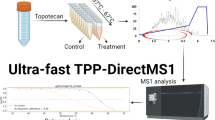Abstract
Nanoelectrospray (nanoES) tandem mass spectrometry was used to examine covalently modified peptides in crude enzymatic digests of human serum albumin (HSA) that had been exposed to either benzo[a]pyrene diol epoxide (B[a]PDE, 1), chrysene diol epoxide (CDE, 2), 5-methylchrysene diol epoxide (5MeCDE, 3), or benzo[g]chrysene diol epoxide (B[g]CDE, 4). The low flow rates of nanoES (∼20 nL/min) allowed several MS/MS experiments to be optimized and performed on a single sample with very little sample consumption (∼30 min analysis time/µL sample). Initially, nanoES was compared with conventional LC/MS/MS analysis of carcinogen-peptide adducts. For example, nanoES analysis of an unseparated digest of B[a]PDE-treated serum albumin revealed the same peptides (RRHPY and RRHPY-FYAPE) that were previously shown, by LC/MS/MS, to be adducted with B[a]PDE. In addition, nanoES could detect unstable peptide adducts that might not otherwise have been directly observable. Finally, nanoES was shown to be an effective way to screen mixtures of modified and unmodified peptides for which no chromatographic information is available.
Similar content being viewed by others
References
Calleman, C. J.; Ehrenberg, L.; Jansson, B.; Osterman-Golkar, S.; Segerbäck, D.; Sverisson, K.; Wachtneister, C. A. Monitoring and risk assessment by means of alkyl groups in hemoglobin in persons occupationally exposed to ethylene oxide. J. Environ. Pathol. Toxicol. 1978, 2, 427–444.
Ehrenberg, L.; Osterman-Golkar, S. Alkylation of macromolecules for detecting mutagenic agents. Teratog. Carcinog. Mutag. 1980, 1, 105–127.
Osterman-Golkar, S.; Ehrenberg, L.; Segerbäck, D.; Hallstrom, I. Evaluation of genetic risks of alkylating agents. II. Haemoglobin as a dose monitor. Mutat. Res. 1976, 34, 1–10.
Osterman-Golkar, S.; Hultmark, D.; Segerbäck, D.; Calleman, C. J.; Gothe, R.; Ehrenberg, L.; Hallstrom, I. Alkylation of DNA and proteins in mice exposed to vinyl chloride. Biochem. Biophys. Res. Commun. 1977, 76, 259–266.
Skipper, P. L.; Tannenbaum, S. R. Protein adducts in the molecular dosimetry of chemical carcinogens. Carcinogenesis 1990, 11, 507–518.
Skipper, P. L.; Tannenbaum, S. R. Molecular dosimetry of aromatic amines in human populations. Environ. Health Persp. 1994, 102, Suppl. 17–21.
Tannenbaum, S. R.; Skipper, P. L.; Wishnok, J. S.; Stillwell, W. G.; Day, B. W.; Taghizadeh, K. Characterization of various classes of protein adducts. Environ. Health Persp. 1993, 99, 51–55.
Brunmark, P.; Harriman, S.; Skipper, P. L.; Wishnok, J. S.; Amin, S.; Tannenbaum, S. R. Identification of subdomain IB in human serum albumin as a major binding site for polycyclic aromatic hydrocarbon epoxides Chem. Res. Toxicol. 1997, 10, 880–886.
Day, B. W.; Skipper, P. L.; Zaia, J.; Tannenbaum, S. R. Benzo[a]pyrene anti-diol epoxide covalently modifies human serum albumin carboxylate side chains and imidazole side chain of histidine(146). J. Am. Chem. Soc. 1991, 113, 8505–8509.
Zaia, J.; Biemann, K. Characteristics of high energy collision-induced dissociation tandem mass spectra of polycyclic aromatic hydrocarbon diolepoxide adducted peptides. J. Am. Soc. Mass Spectrom. 1994, 5, 649–654.
Wilm, M. S.; Mann, M. Electrospray and Taylor-Cone theory, Dole’s beam of macromolecules at last? Int. J. Mass Spectrom. Ion Proc. 1994, 136, 167–180.
Wilm, M.; Mann, M. Analytical properties of the nanoelectrospray ion source. Anal. Chem. 1996, 68, 1–8.
Wilm, M.; Shevchenko, A.; Houthaeve, T.; Brelt, S.; Schweigerer, L.; Fotsis, T.; Mann, M. Femtomole sequencing of proteins from polyacrylamide gels by nanoelectrospray mass spectrometry. Nature 1996, 379, 466–469.
Shevchenko, A.; Wilm, M.; Vorm, O.; Mann, M. Mass spectrometric sequencing of proteins from silver-stained polyacrylamide gels. Anal. Chem. 1996, 68, 259–266.
Davis, M. T.; Stahl, D. C.; Hefta, S. A.; Lee, T. D. A microscale electrospray interface for on-line, capillary liquid chromatography/tandem mass spectrometry of complex peptide mixtures. Anal. Chem. 1995, 67, 4549–4556.
Korner, R.; Wilm, M.; Morand, K.; Schubert, M. Nano electrospray combined with a quadrupole ion trap for the analysis of peptides and protein digests. J. Am. Soc. Mass Spectrom. 1996, 7, 150–156.
Valaskovic, G. A.; Kelleher, N. L.; Little, D. P.; Aasuerud, D. J.; McLafferty, F. W. Attomole sensitivity electrospray source for large-molecule mass spectrometry. Anal. Chem. 1995, 67, 3802–3805.
Stryer, L. Biochemistry; W. H. Freeman:New Yok, 1988, pp 57–58.
Allen, G. , in Laboratory Techniques in Biochemistry and Molecular Biology; Burdon, R. H. , van Knippenberg, P. H. , Eds. ; Elsevier, New York, 1989, p 58.
Baker, P. ; Clauser, K. MS-FIT. http://prospector. ucsf. edu/htmluscf/msfit-htm
RamaKrishna, N. V. S.; Gao, F.; Padmavathi, N. S.; Cavalieri, E. L.; Rogan, E. G.; Cerny, R. L.; Gross, M. L. Model adducts of benzo[a]pyrene and nucleosides formed from its radical cation and diol epoxide Chem. Res. Toxicol. 1992, 5, 293–301.
Szeliga, J.; Page, J. E.; Hilton, B. D.; Kiselyov, A. S.; Harvey, R. G.; Dunayevskiy, Y. M.; Vouros, P.; Dipple, A. Characterization of DNA adducts formed by anti-benzo[g]chrysene 11,12-dihydrodiol 13,14-epoxide Chem. Res. Toxicol. 1995, 8, 1014–1019.
Annan, R. S.; Giese, R. W.; Vouros, P. Detection and structural characterization of amino polyaromatic hydrocarbon-de-oxynucleoside adducts using fast atom bombardment and tandem mass spectrometry Anal. Biochem. 1990, 191, 86–95
Day, B. W.; Skipper, P. L.; Zaia, J.; Singh, K.; Tannenbaum, S. R. Enantiospecificity of covalent adduct formation by benzo[a]pyrene anti-diol epoxide with human serum albumin Chem. Res. Toxicol. 1994, 7, 829–835
Day, B. W.; Skipper, P. L.; Rich, R. H.; Naylor, S.; Tannenbaum, S. R. Conversion of a hemoglobin alpha-chain aspartate(47) ester to N-(2,3-dihydroxypropyl)asparagine as a method for the identification of the principal binding site for benzo[a]pyrene anti-diol epoxide Chem. Res. Toxicol. 1991, 4, 359–363.
Roepstorff, P.; Fohlman, J. Proposal for a common nomenclature for sequence ions in mass spectra of peptides Biomed. Mass Spectrom. 1984, 11, 601.
Author information
Authors and Affiliations
Corresponding author
Rights and permissions
About this article
Cite this article
Harriman, S.P., Hill, J.A., Tannenbaum, S.R. et al. Detection and identification of carcinogen-peptide adducts by nanoelectrospray tandem mass spectrometry. J Am Soc Mass Spectrom 9, 202–207 (1998). https://doi.org/10.1016/S1044-0305(97)00252-3
Received:
Revised:
Accepted:
Issue Date:
DOI: https://doi.org/10.1016/S1044-0305(97)00252-3




